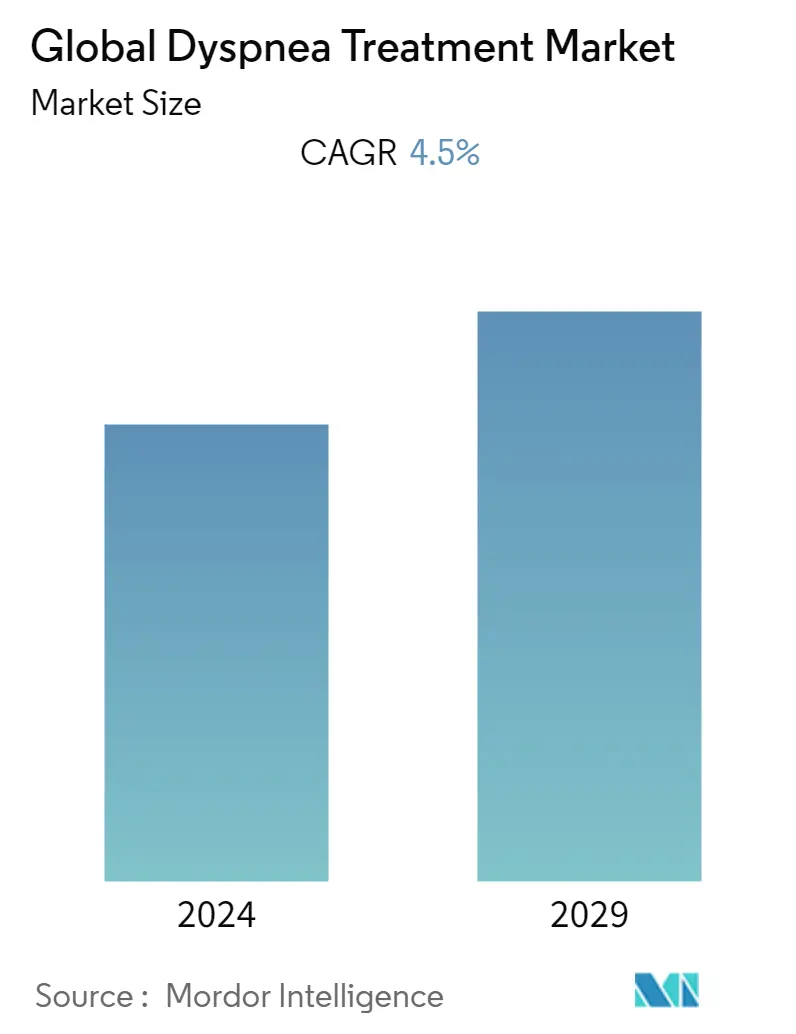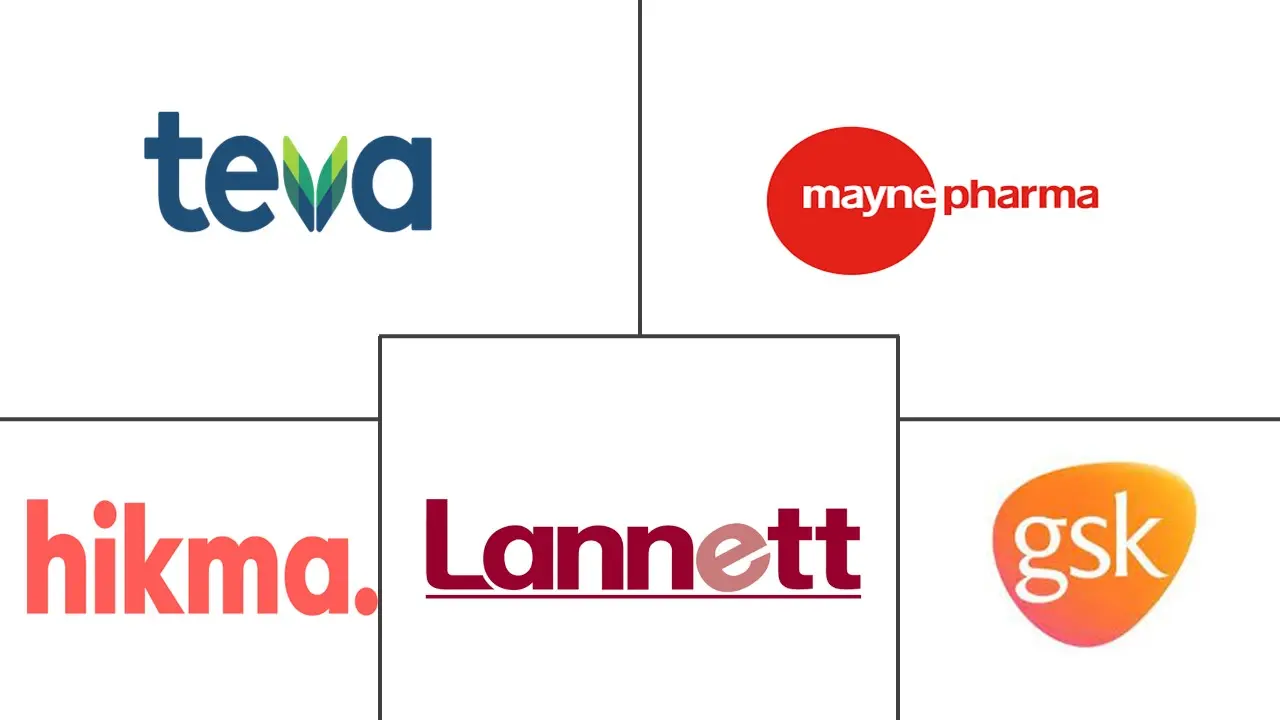Market Size of Global Dyspnea Treatment Industry

| Study Period | 2019 - 2029 |
| Base Year For Estimation | 2023 |
| CAGR | 4.50 % |
| Fastest Growing Market | North America |
| Largest Market | Asia-Pacific |
| Market Concentration | Medium |
Major Players
*Disclaimer: Major Players sorted in no particular order |
Dyspnea Treatment Market Analysis
Dyspnea Treatment Market is expected to grow at a registered CAGR of 4.5% during the forecast period.
According to the study titled "Dyspnea: The vanished warning symptom of COVID19 pneumonia" published in November 2020, dyspnea is slightly more common in patients who develop acute SARS-CoV-2 infection and have the worst clinical outcomes. In the general population, in people with chronic obstructive pulmonary disease, dyspnea has been strongly linked to a poor prognosis. Moreover, as per the same source, less than 50% of SARS-COV-2 infected patients had been reported to experience dyspnea, a subjective feeling of breathing discomfort. As a result, it was anticipated that demand for dyspnea treatments would increase; however, because of a weak supply chain, the market suffers during a pandemic
The increase in the prevalence of COPD and asthma, which are the main causes of dyspnea and its causative symptoms, is what is driving the global market for dyspnea treatments. The main causes of dyspnea are a high prevalence of cardiopulmonary diseases, a rise in obesity among people, and alterations in lifestyle. According to the study titled "Prevalence and severity of different dimensions of breathlessness among elderly males in the population" published in the European Respiratory Journal in February 2022, breathlessness has been a common symptom of cardiorespiratory disease, as well as a prevalent symptom in the general population. Shortness of breath affects 10-25% of adults in their middle years and older during regular activity. Therefore, increasing dyspnea prevalence is anticipated to result in increased demand for its management and treatment, which will propel market expansion. Additionally, COPD and asthma are the main contributors to dyspnea, and the rising prevalence of these conditions will fuel market expansion over the forecast period. According to the World Health Organization (WHO) 2021 factsheet, asthma is a major non-communicable disease (NCD), that affects both children and adults. Globally, around 262 million people had asthma in 2020, which is expected to boost the demand of dyspnea treatment among people suffering from Asthma.
Furthermore, the global market for dyspnea treatments is expanding as a result of rising air pollution levels and toxicity exposure that causes breathlessness in the populace. According to the United States Environmental Protection Agency in June 2022, health could be negatively impacted by ozone in the air, especially on hot, sunny days when ozone levels could rise dangerously high. People with asthma, children, elderly people, and those who engage in outdoor activities were at risk from breathing ozone-containing air. Thus, increasing exposure to toxic substances and air pollution may significantly increase the likelihood of developing dyspnea, fueling the market growth over the projected period.
Thus, all aforementioned factors are expected to boost the market growth over the forecast period, however, the high cost associated with the treatment may restrain the market growth.
Dyspnea Treatment Industry Segmentation
As per the scope of the report, dyspnea, also referred to as air hunger, is characterized as shortness of breath. Mild, transient, serious, and persistent shortness of breath is all possible. Dyspnea can be brought on by excessive exertion, spending time at high altitudes, and a variety of other conditions. Dyspnea Treatment Market is segmented By Treatment Type (Therapy (Supplemental Oxygen Therapy, Relaxation Therapy), Drugs (Antianxiety Drugs, Antibiotics, Anticholinergic Agents, Corticosteroids, Others), End-user (Hospitals, Home Care, Specialty Centers, Others), and Geography (North America, Europe, Asia-Pacific, and Rest of the World). The report offers the value (in USD million) for the above segments.
| By Treatment type | |||||||
| |||||||
|
| By End User | |
| Hospitals | |
| Home Care | |
| Specialty Centers | |
| Others |
| Geography | ||||||||
| ||||||||
| ||||||||
| ||||||||
| Rest of the World |
Global Dyspnea Treatment Market Size Summary
The dyspnea treatment market is poised for growth, driven by the increasing prevalence of chronic obstructive pulmonary disease (COPD) and asthma, which are significant contributors to dyspnea. The rise in cardiopulmonary diseases, obesity, and lifestyle changes further exacerbates the condition, leading to a higher demand for effective management and treatment solutions. The market is also influenced by environmental factors such as air pollution and exposure to toxic substances, which can aggravate respiratory conditions and increase the incidence of dyspnea. Despite the challenges posed by supply chain disruptions during the pandemic, the market is expected to expand, supported by advancements in treatment options and the growing recognition of dyspnea as a critical health issue.
North America currently leads the global dyspnea treatment market, benefiting from a well-established healthcare system, a high prevalence of relevant health conditions, and the presence of major market players. The region's market growth is further bolstered by increasing product approvals and ongoing clinical trials aimed at improving treatment outcomes. The market is characterized by a few dominant players, but technological advancements and product innovations are enabling mid-size and small-scale companies to enhance their market presence. The introduction of new devices, such as portable oxygen concentrators and multifunctional noninvasive ventilators, is expected to drive competition and contribute to the market's expansion over the forecast period.
Global Dyspnea Treatment Market Size - Table of Contents
-
1. MARKET DYNAMICS
-
1.1 Market Overview
-
1.2 Market Drivers
-
1.2.1 Rising in Prevalence of Dyspnea and its Associated Disorders
-
1.2.2 Increasing Levels of Air Pollution and Exposure to Various Toxins
-
-
1.3 Market Restraints
-
1.3.1 High Costs Associated with The Treatment
-
-
1.4 Porter's Five Force Analysis
-
1.4.1 Threat of New Entrants
-
1.4.2 Bargaining Power of Buyers/Consumers
-
1.4.3 Bargaining Power of Suppliers
-
1.4.4 Threat of Substitute Products
-
1.4.5 Intensity of Competitive Rivalry
-
-
-
2. MARKET SEGMENTATION (Market Size by Value - USD Million)
-
2.1 By Treatment type
-
2.1.1 By Therapy
-
2.1.1.1 Supplemental Oxygen Therapy
-
2.1.1.2 Relaxation Therapy
-
-
2.1.2 By Drug Class
-
2.1.2.1 Antianxiety Drugs
-
2.1.2.2 Antibiotics
-
2.1.2.3 Anticholinergic Agents
-
2.1.2.4 Corticosteroids
-
2.1.2.5 Others
-
-
-
2.2 By End User
-
2.2.1 Hospitals
-
2.2.2 Home Care
-
2.2.3 Specialty Centers
-
2.2.4 Others
-
-
2.3 Geography
-
2.3.1 North America
-
2.3.1.1 United States
-
2.3.1.2 Canada
-
2.3.1.3 Mexico
-
-
2.3.2 Europe
-
2.3.2.1 Germany
-
2.3.2.2 United Kingdom
-
2.3.2.3 France
-
2.3.2.4 Italy
-
2.3.2.5 Spain
-
2.3.2.6 Rest of Europe
-
-
2.3.3 Asia-Pacific
-
2.3.3.1 China
-
2.3.3.2 Japan
-
2.3.3.3 India
-
2.3.3.4 Australia
-
2.3.3.5 South Korea
-
2.3.3.6 Rest of Asia-Pacific
-
-
2.3.4 Rest of the World
-
-
Global Dyspnea Treatment Market Size FAQs
What is the current Global Dyspnea Treatment Market size?
The Global Dyspnea Treatment Market is projected to register a CAGR of 4.5% during the forecast period (2024-2029)
Who are the key players in Global Dyspnea Treatment Market?
Mayne Pharma Group Limited, Hikma Pharmaceuticals plc, Lannett Company, Inc., GlaxoSmithKline and Teva Pharmaceutical Industries Ltd are the major companies operating in the Global Dyspnea Treatment Market.

